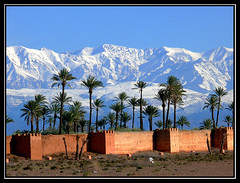 So flying from Rabat to Paris, I'm back in the "international style" of travel. The Charles de Gaulle airport is great architecture, but it's hard to get from terminal to terminal and when your plane is delayed, well, sleeping on the floor of an airport has the same feel regardless of architect's vision.
So flying from Rabat to Paris, I'm back in the "international style" of travel. The Charles de Gaulle airport is great architecture, but it's hard to get from terminal to terminal and when your plane is delayed, well, sleeping on the floor of an airport has the same feel regardless of architect's vision. Of the images of Morocco, the ones that stick in my head are the abrupt contrasts between the traditional and the modern: the burka clad women riding their mopeds as aggressively as any teenager in Italy, the young guys surfing on the Rabat beach under the high walls of the kasbah, the modern trains rolling through fields of wheat being harvested by hand, the broad boulevards named after the king's grandfather which end at the gates to the old walled city.... I left without a sense of how these opposites fit together and, yet, in some way they does. Perhaps the contrast is just in my mind. This westerner who does not understand el Magrib, the "far west" that Morocco represented to the Arab world of North Aftica, this place of Berbers, Arabs, the French and the Spanish, the African and the European...this middle earth.
On my last night in Marrakesh, I paid admittance to one of the terraces overlooking the Jemma el Fna...that great plaza filled with vendors, story tellers, tourists, musicians, food stalls and sellers of herbs and medicines. I found myself standing next to an American woman, living in Germany, who was in Morocco as part of a tour group. As we talked, I shot some video of the scene unfolding beneath us...as it does every night...a scene populated by Moroccans, doing what they have done for many, many years at this northern terminus of the Sahara caravans that once moved ivory, slaves, salt across the desert.

















